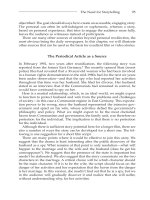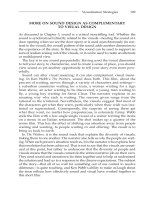Writing the short film 3th - Part 15
Bạn đang xem bản rút gọn của tài liệu. Xem và tải ngay bản đầy đủ của tài liệu tại đây (121.35 KB, 7 trang )
Ch08.qxd 9/27/04 6:06 PM Page 88
8
THE NEED FOR
STORYTELLING
We need look no further than the number of television channels—to say
nothing of the number of hours that television broadcasts news stories,
sports stories, nonfiction stories, and fiction stories, stories of all lengths—to
realize the number of stories available to the public every day. Add the num-
ber of films, newspapers and magazines, and oral stories (from jokes to anec-
dotes to elaborate tales, from gossip to reportage, from free association to
analytic interpretation), and it is evident we are all telling stories. There are
stories on every level, from casual to the most meaningful. It’s not so much
that we hunger for any one kind of story but rather that we need a full range
of stories. Human experience functions on a wide band, from superficial to
deeply meaningful, and storytelling reflects that human experience.
Why do we need stories? We need them to help us make sense of our
world, both the past and the present so we can make our way to a future.
But there are other reasons stories have been important, beyond the need
to understand, and one is the need of the teller to communicate. Whether in
pantomime or Elizabethan tragedy, storytellers want to communicate with
others. The cave painter and the short-film director may have different
means, but both want to use their medium to bind artist and audience
together for that instant or that half-hour of the storytelling experience. For
that time, storyteller and audience become a community, with all the histor-
ical implications of the relationship between artist and audience.
Another reason for storytelling is the education of the community. Many
cultures have used storytelling to educate, particularly about the ethics of
living in the society. The passing on of tradition and ethics has been a cen-
tral focus of storytelling, from the fairy tale to the fable to the documentary
film. Finally, storytelling provides a legitimate access route to the world of
our dreams and our fears; it provides an outlet for both of these types of
89
Ch08.qxd 9/27/04 6:06 PM Page 89
psychic experiences. The goal of the story is to incorporate these dimen-
sions of life into consciousness. Dreams and fears are important elements
of storytelling.
STORYTELLING STRATEGIES
Although screen stories have unique qualities particular to film, screen sto-
ries for both short and long films often share characteristics with other kinds
of storytelling. In this chapter, we will discuss those general qualities and
suggest links to other forms of storytelling, forms that provide the first and
best source of material for short films.
STORY QUALITIES
All stories must engage the curiosity of an audience, whether that audience
be one or a thousand. The storyteller must build on that curiosity, inviting
our involvement in a character’s situation, and finally allow the viewer to
identify with the character and the situation.
To hold the audience and move it through the story, a variety of devices
are used. Some are operating principles; others are artificial techniques. But
no matter what device is used, the goal is the same—to move the audience
from curiosity to a more emotional state. If the story works, the results can
range from amusement to tragedy. In each case, it is the storytelling qualities
that transcend the medium and hold the audience’s attention.
These story qualities can be broken down into two groups: character quali-
ties, and plot qualities. The primary character quality of a story is that we have
to identify with the main character if we are to be engaged with the story. We
have to become concerned with his or her dilemma, and we have to care
about the outcome.
In order to identify with the characters, we have to know who they are and
how they’ve arrived at the point where we join the story. A main character
may be active or passive, young or old, male or female. These qualities
should be specific and appropriate to the story; it is no use telling a story
about a passive Olympic athlete, because the drive to become an Olympic
athlete requires, by definition, a forceful rather than passive character.
Specificity about culture, family, and career is also helpful in creating a per-
son we recognize.
What are the person’s goals? What are his or her hopes, dreams, fears?
Any or all of these details can also help create a recognizable character. That
recognition is the first step toward identification—if we recognize the char-
acter and his or her situation, we will begin to connect with the character.
90 Writing the Short Film
Ch08.qxd 9/27/04 6:06 PM Page 90
As much as our identification with the main character relies on our recog-
nizing and caring about the character, that identification can be equally
influenced by the role of the antagonist. The antagonist can be a mountain, a
desert, or a raging storm; it can be an angry father, an overprotective mother,
or an unjust boss. Often the most interesting antagonist of all can be one’s self:
our own flaws (fear, greed, anger, passivity) can play the role of the enemy.
As we have observed, the more forceful the antagonist in a story, the
greater the struggle of the protagonist. If the goal of the story is to portray
heroic behavior, the role of the antagonist can be crucial. If the goal is more
to portray realism and complexity in the protagonist’s actions, here too the
character of the antagonist is critical.
It is notable that the characters of the protagonist and antagonist are fre-
quently opposites, often in appearance as well as behavior. This polarity of
protagonist and antagonist is the most overt use of opposites in storytelling.
Polarized characteristics are also used with characters other than protago-
nists or antagonists, and to good effect. The greater the number of polarities
in the story, the greater the conflict and the resulting interest to the reader,
listener, or viewer. Polarity is an extremely useful storytelling device.
Plot qualities are closely related to character, but because they involve
events outside of character, they can be considered separately. A good exam-
ple of this notion is the role of conflict in storytelling: the more powerful the
barriers that stand in the way of the character achieving his or her goal, the
more compelling the plot. If the character faces no barriers in achieving his
or her goal, there is no story. This is the nature and the role of conflict in sto-
rytelling—to provide barriers to the characters and their goals.
What if the character does not have a goal? This will pose a problem for
developing a conflict. What if the character’s goal is unrealistic? The story-
teller may focus on the conflict inherent in discovering that the goal is unat-
tainable. In both examples, the linkage of conflict to character is intentional.
Plot cannot stand alone, outside of character, without the story suffering
because of it. Character, plot, and conflict are intricately related to one
another. One dimension of conflict is how much a character wants to achieve
his or her goal. Does the character want, desire, or need to achieve this goal?
The greater the desire of the character, the greater the potential for conflict.
The parallel with regard to the plot is also true: the more powerful the resist-
ance, whether through the antagonist or other forces, the greater the conflict
potential. Remember that barriers to the character’s goal may be external (a
place, another person) or internal. What is most important to the story is that
the viewers or readers understand that the barriers are the source of conflict
for the character. From the most simple fable, such as “The Tortoise and the
Hare,” to a complex short story, such as Hemingway’s “The Snows of
Kilimanjaro,” the sources of conflict are clear to the readers, and as the story
progresses they become clear to the protagonist.
The Need for Storytelling 91
Ch08.qxd 9/27/04 6:06 PM Page 91
Whether the character succeeds in the conflict, as in “The Tortoise and the
Hare,” or fails, as in “The Snows of Kilimanjaro,” it is the struggle to overcome
the barriers that is the fabric of the story. In each case, the motivation of the pro-
tagonist to triumph over conflict seems primal, and that desire fuels our iden-
tification and understanding. Good stories tend to have a powerful conflict
associated with a character we understand and whose desire fuels the story.
The first notable characteristic of a good story is that it presents an interest-
ing interpretation of a situation that, on one level, we have seen before. A spe-
cific example will illustrate this. We are all familiar with the experience of the
first day of school; the situation conjures up all kinds of associations for each
person. Building on our familiarity with this situation, we can make it more
interesting and arouse curiosity by introducing a new factor—the age of the
new student. What if the new student in the local high school is 40 years old,
and he is joining a class full of 14-year-olds? The key here is that there is com-
fort for the viewer or reader in known situations—birthdays, weddings, funer-
als, and first days of school. The good storyteller uses our knowledge of the
situation and whets our appetite for the story by introducing a new element.
Another factor in the plot is that point at which the storyteller chooses to
join the story. It is crucial that the writer joins the story at a point where the
dramatic possibilities can be maximized. The goal of the storyteller is to
energize the tale, and the point of entry is critical in accomplishing this goal.
For example, we join Ambrose Bierce’s short story “An Occurrence at Owl
Creek Bridge” at the point when a civilian has been caught trespassing on a
bridge held by Union soldiers during the Civil War.
1
Will the unfortunate
Southerner die for his transgression, or escape to safety? This question forms
the substance of the story that unfolds.
At the beginning of Raymond Carver’s short story “Cathedral,” a blind man,
who has recently lost his wife, plans to visit an old friend and her husband.
2
The issue is whether the friend’s rocky marriage can bear a visitation from a
sightless rival. The main character is the husband in the problematic relation-
ship. The announcement of the visit is the point at which we join the story.
Good storytellers will find a point to join a story that will serve to gener-
ate tension and attract attention. If we do not join the story at such a point,
not only is dramatic opportunity lost, but the chance to harness the audi-
ence’s curiosity will be lost, too. We will, in effect, be waiting for the story to
begin. To summarize, an interesting situation, a strong entry point, and
enough conflict are necessary to start the story.
PLOT STRATEGIES
In order to carry us through the story, the storyteller relies on two plot strate-
gies—surprise (or reversal), and a rising level of action in the course of the plot.
92 Writing the Short Film
Ch08.qxd 9/27/04 6:06 PM Page 92









